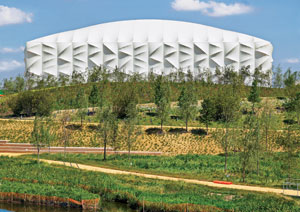Wave of the Future
Basketball Arena
Wilkinson Eyre Architects
 |
While the Aquatics Centre and Stadium were designed to be scaled down after the Games, officials took a much different approach for the Basketball Arena, developing a brief for a 12,000-seat temporary venue that could be completely disassembled with at least two-thirds of its components reused or recycled, or reerected elsewhere. In response, the design team, which included architect Wilkinson Eyre and structural engineer SKM, explored a number of schemes, such as a cable-net structure and a geodesic dome, evaluating these options on the basis of cost, ease of construction, and the ability to be disassembled and reused. They eventually settled on a steel-portal frame, but one with a shallow barrel roof, rather than the more typical pitched roof. The volume is covered with 215,000 square feet of PVC membrane, creating a building with a profile that Wilkinson Eyre associate director Sam Wright likens to a loaf of bread. “We didn't want to present a blunt, gabled end to the park,” he says.
The arena is far from plain white bread, however. It has plenty of surface articulation provided by sub-dividing its elevations into 19-foot-wide-by-80-foot-tall bays. These include a secondary frame of protruding radial steel arches arranged in three different combinations. The units are used both right side up and upside down, producing six modular variations and a seemingly random, undulating surface. These bays, which have fittings that allow the membrane to be “unzipped,” can be disassembled and then reerected or reconfigured, explains Jim Eyre, Wilkinson Eyre director.
The arena's remaining components have also been designed to facilitate their reuse, depending on many of the same strategies deployed in other venues. The structure supporting the seating, for example, is self standing and is bolted together rather than welded, as is the portal frame. And to keep the arena compact, the team relied on an approach similar to that used for the concessions at the main stadium: The arena's support services, including warm-up courts, areas for catering, and security, are housed in an adjacent modular building that Eyre refers to as a “bar of accommodation.”
One especially unusual aspect of the arena was the method used to procure it. The building was divided into six packages, each separately bid: the portal frame and the PVC envelope; the seating and the seating bowl; the interior fit-out; the mechanical and electrical work; and the foundations. The responsibility for reusing or recycling the elements within these packages lies with the contractors, making it hard to predict where the arena's individual pieces will eventually land. However, the textured shell and its portal frame could well be traveling to Brazil for the 2016 Games. According to LLDC, officials from Rio de Janeiro and the supplier of the membrane and its underlying structure have been discussing such a possibility.
If the Basketball Arena's envelope travels to Brazil, it will certainly help validate London's approach to planning the Games. But to more accurately gauge London's accomplishments, we will have to wait more than four years, watching all the while to see how well facilities like the pool, the stadium, and the park as a whole meet community needs, and if the hoped-for regeneration actually materializes. If the Olympic site transforms into “a real piece of the city,” as AECOM's Prior hopes, the 2012 Games will have been a true success.








